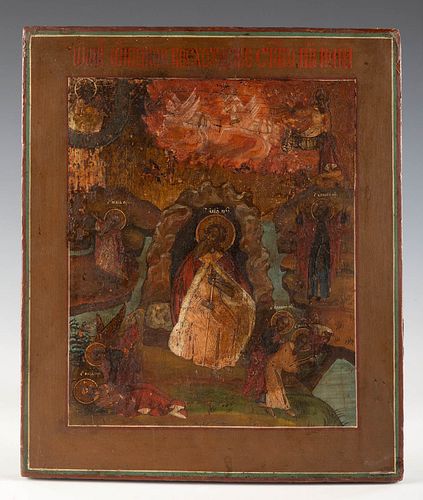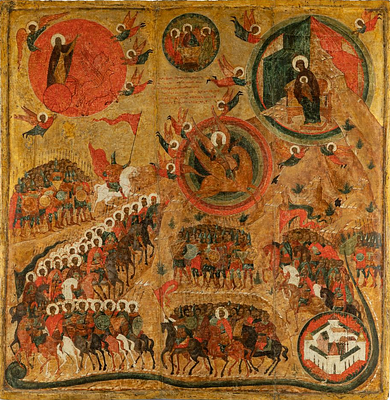Russian school, 18th-19th centuries. "Elijah in the Wilderness". Tempera on panel.
Lot 35
About Seller
Setdart Auction House
Carrer Aragó 346
Barcelona
Spain
Setdart Subastas was born in 2004 and is currently the first online art auction in Spain with solidity, prestige and reliability guaranteed by our more than 60,000 users. Setdart has a young, dynamic and enterprising team ready to successfully manage the purchase and sale of art works through custom...Read more
Estimate:
EUR€1,000 - EUR€1,200
$1,041.67 - $1,250
Absentee vs Live bid
Two ways to bid:
- Leave a max absentee bid and the platform will bid on your behalf up to your maximum bid during the live auction.
- Bid live during the auction and your bids will be submitted real-time to the auctioneer.
Bid Increments
| Price | Bid Increment |
|---|---|
| EUR€0 | EUR€10 |
| EUR€200 | EUR€25 |
| EUR€500 | EUR€50 |
| EUR€1,000 | EUR€100 |
| EUR€3,000 | EUR€200 |
| EUR€5,000 | EUR€500 |
| EUR€10,000 | EUR€1,000 |
| EUR€20,000 | EUR€2,000 |
| EUR€50,000 | EUR€5,000 |
About Auction
By Setdart Auction House
Sep 23, 2021
Set Reminder
2021-09-23 10:00:00
2021-09-23 10:00:00
America/New_York
Bidsquare
Bidsquare : RUSSIAN ICONS
https://www.bidsquare.com/auctions/setdart-auction-house/russian-icons-7431
Setdart Auction House sofia@setdart.com
Setdart Auction House sofia@setdart.com
- Lot Description
Russian school, 18th-19th centuries. "Elijah in the Wilderness". Tempera on panel. Measurements: 31 x 26.5 cm. This work refers to another thematic icon called "Elijah in the Desert", painted by Fyodor Evtyjeev Zubov between 1659 and 1662, for the church of the saint in Yaroslavl (Russia). It is a classic image par excellence of Russian iconography, now in the Museum of Fine Arts in Yaroslavl. The anonymous master of our piece depicts Elijah in the centre of the icon, according to the canon: seated on a stone, leaning on a staff. The saint, who turns his face towards the raven bringing him a loaf of bread, is surrounded by nature. Instead of hagiographic cells, known in Russian as "kleimó" and typical of traditional Orthodox iconography, our master opted for the less common but equally common miniatures, which form a circular composition. The scenes should be read from the upper left corner downwards, ending in the upper right corner. It is true that this icon has some deterioration, but even so all the scenes can be clearly seen, because the inscriptions are preserved, a characteristic feature of orthodox iconography. The first miniature shows the Pantocrator. It is followed by a scene with Elijah, probably when Elijah spoke with God. The third scene describes the descent of the angel in Elijah's dream. It is followed by a scene depicting one of his miracles, when he touched the waters of the Jordan River with his clothes, and the waters parted, just as they did for Moses. In the penultimate miniature we see the prophet Elisha, who frequently accompanies Elijah. . Finally, the composition culminates with Elijah's ascension to heaven, even though he is mortal, thus symbolising his great virtue. In addition to depicting Elijah's life with iconographic accuracy, the anonymous author improvises freely, enriching the icon with landscapes and seascapes. Elijah was one of the most revered Old Testament saints in Old Rus, even before the Christianisation of Rus in 988. Today he is considered the protector of the air force. He is one of the few prophets equally esteemed in Islam, Judaism and Christianity. There is very little information about his origin and his name, which probably comes from Hebrew and means "my God is Yahweh (the one God)", is not known exactly. During his lifetime, Elijah openly criticised the pagan king of Israel, Ahab, and his wife Jezebel. Because of their lack of faith in Christianity, God punished Israel with a drought, which lasted three years. During this period, Elijah lived in the desert, next to a small river, or a natural water source, and was fed with the help of the ravens that brought him food. The central scene of our icon represents precisely this episode, the colours of ochre, red, and yellowish tones, help to convey the sensation of heat and drought, in an uninhabited desert. When the people of Israel finally had enough, Elijah offered to test them by building two altars, one pagan and one Christian. The one on which the fire would fall that night would be the religion to follow. God lit the Christian altar, putting an end to paganism in Israel. As a gift for this rigorous faith and virtue, Elijah was ascended to heaven.
- Shipping Info
-
In-house shipping available. Please inquire at admin@setdart.com.
-
- Buyer's Premium



 EUR
EUR CAD
CAD AUD
AUD GBP
GBP MXN
MXN HKD
HKD CNY
CNY MYR
MYR SEK
SEK SGD
SGD CHF
CHF THB
THB














